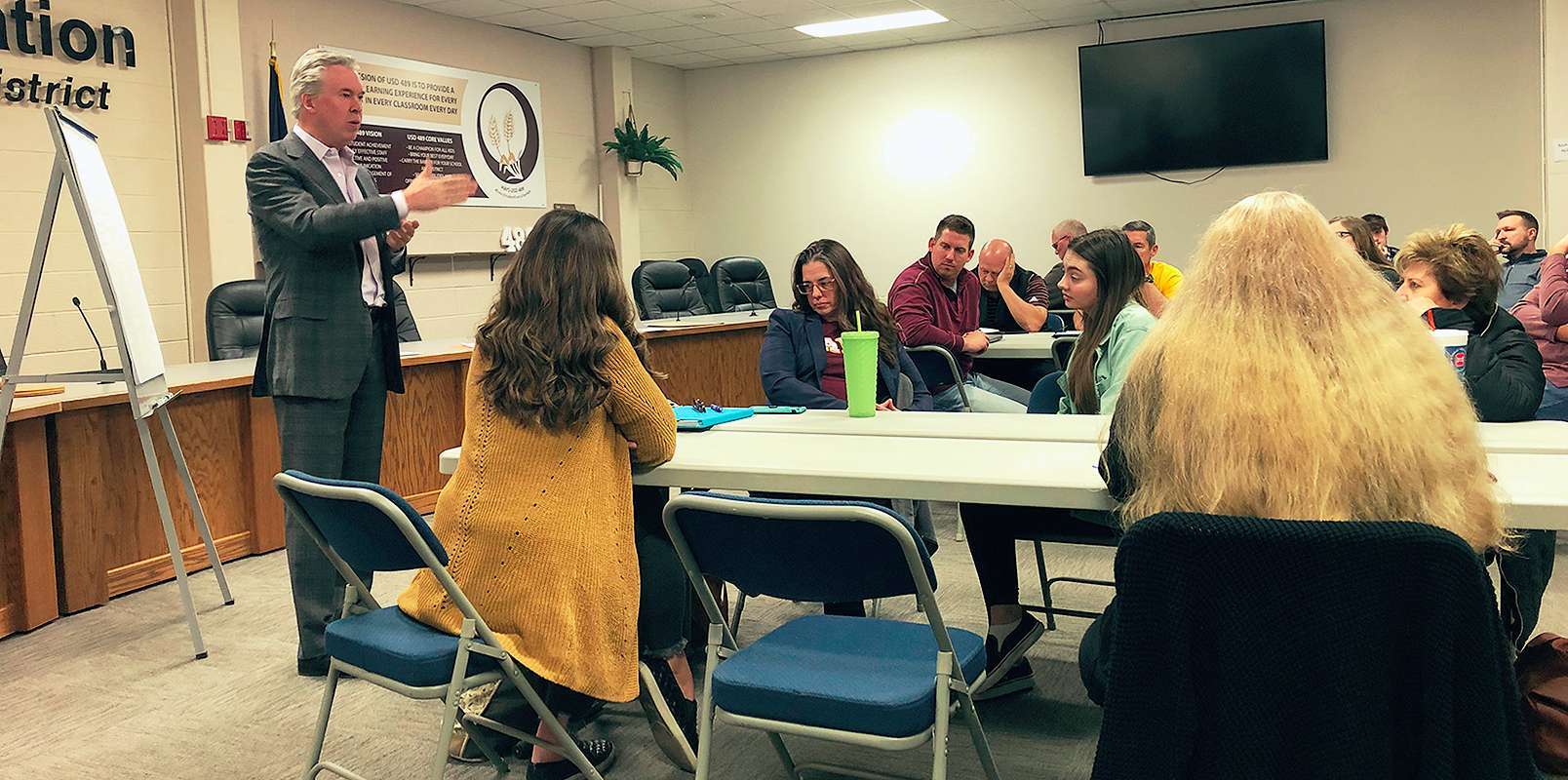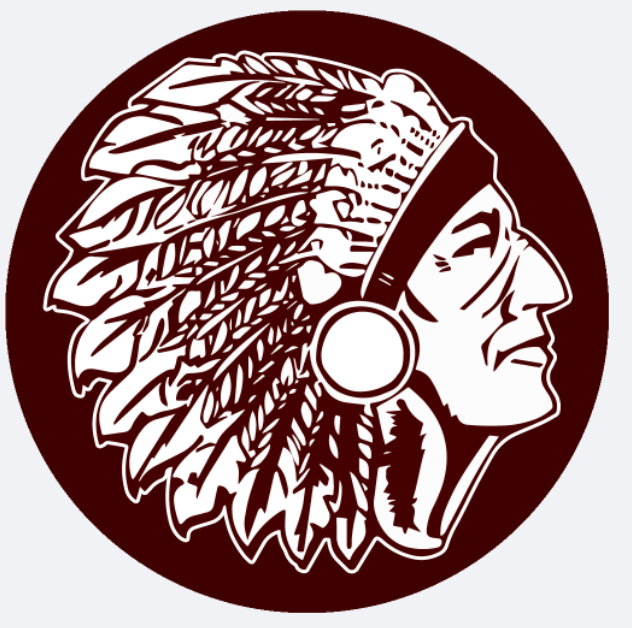
By CRISTINA JANNEY
Hays Post
HAYS — A rebranding committee is still split on the potentially offensive nature of Hays High School's Indian mascot.
The Hays USD 489 school district rebranding committee met for the first time on Monday night.
The school district conducted a survey and found a majority of respondents wanted to keep the Indian mascot. However, at a community meeting on Nov. 15 and at the rebranding meeting Monday, some community members said they believe the high school mascot should be changed.
The school district passed a bond issue in May and is in the process of building a new high school and will be remodeling the current high school into a middle school.
Superintendent Ron Wilson said his desire is to see the district put the right mark on those schools.
John Jenson, Josten's consultant, has been leading the rebranding discussions. He tried to focus the group on the words "brave and true" from the high school's fight song.
Committee members seemed to agree that they liked the school's maroon and gold colors and wanted to keep them.
Jenson presented some potential logo options that include brushes of maroon and gold, keeping the Indian name and using the "brave and true" theme.

None of the options included the Indian head or the spearhead that has recently been used by the Hays High football team.
Jenson said he thought the color slashes could be symbolic of war paint.
"If we're calling ourselves the Indians and also using paint behind it, I can see how that would bother some people. I think it depends on what it's paired with," said Anniston Weber, 2017 HHS graduate.
Several committee members said they did not like the imagery of war paint. Others said they did not like the use of color slashes only. They said they wanted an image.
"Keep in mind that of the surveys that I got back the people who didn't want the Indian were the people who thought it was being portrayed as offensive," Jenson said. "So the question, 'Is how do you get rid of offensive and keep the Indian?' "
Abby Gillan, HHS government teacher and graduate, said she would like to look at the issue of the Indian being offensive in a factual way.
"Here is what the tribes have said. Here is how our culture is evolving. This conversation isn't new," she said.
Gillan said one of her students in a sociology class during a debate on this subject made the point the word Indian is offensive to many indigenous people because it was a name given to them because early European explorers thought they had landed in India.
"It's a term given to people of various cultures that you have made into a monolith, and I think that is where we run into trouble," she said. ... "I think we need to get the historical accuracy right. I think the name could be a big hurdle for unity around our message."
Curt Vajnar, school board member, former USD 489 teacher and parent, said the Indian headdress logo has never been offensive to him.
"I've been proud of it," he said. "I've never ever heard people talk bad about it."
However, he said the school has displayed versions of Indian logos of which he didn't approve. He pulled a skull with a headdress logo off a wrestling mat over the weekend.
Ruth Legleiter, HHS graduate, said she was never offended by the Indian mascot. She said she was proud of it.
"It amazes me that people find it offensive all of the sudden," she said. "We had how many decades of the Indian and everyone was proud of that, now all of the sudden it's a bad word. ...
"No one ever picked the Indian name to be offensive. It was to be proud, and now all of the sudden it's reversed."
USD 489 board member and parent Meagan Zampieri-Lillpopp read aloud from the Kansas-Nebraska Indian Education study, a study out of K-State that was the result of a collaboration between the Kansas Association for native American Study and Nebraska Indian Education Association.
The groups that created the report passed resolutions in 1998 and 2018 asking schools to remove Native American mascots.
Zampieri-Lillpopp further quoted the study to say the mascots create unwelcome and hostile environments for Native American students. Students are reporting lower self-esteem and community worth.
"It is harmful because it reminds Native Americans of the limited ways others see them," Zampieri-Lillpopp quoted the study saying.
Repeated research from these groups has said "The overall research clearly demonstrates that American mascots and branding continue to be detrimental to learning and psychological well-being not only of native students but all students."
Extensive literature exists on this topic and hundreds of professional organizations working across native communities, overwhelming favor eliminating Native American mascots, branding and imagery, she continued.
Vern Ruder's mother is a member of the Blackfoot tribe in Montana.
"The only thing I find offensive is Redskins, but the arrowhead, the war paint, the tribal headgear that's not offensive at all," he said. "People who say that don't have any Native American background."
"You're not going to make everyone happy," he said. "There's a lot of Native Americans who say you are still remembering the Indians, but you have other people who don't like it."
Jenson said in response to Zampieri-Lillpopp, "I think you prove a great point. It can be done in a way that's offensive. I think the discussion here is how it can be done in a way that's not."
Shaun Linenberger, HHS graduate and parent, who also said he has Native American heritage, said people would probably be offended if the high school's mascot was the Volga Germans despite the prevalence of that heritage in the area.
"I take great pride in that I was a Hays High graduate, and I was an Indian," he said.
Gillan said she thought the debate of Indian mascots is part of the public discussion now because as a culture we've made more seats at the table for minority cultures.
Gillan said her students found old mascots that were not as respectful as the current logos. She said the thought the community has come a long way in being more respectful.
"I think we have a very special opportunity to be very purposeful and coordinated and get it over the finish line and do it right," she said.
Jenson said the community needs to determine what it means to be an Indian here.
"You can't allow everyone to define it," he said. "You have to have to come up with that definition yourself.
"If you said what it means to be an Indian here within this district within this city, for example, it means to be brave and true. If that's what it means and you can live that out, you're not speaking for Indians all over the world. You are saying this is what it means right here."





